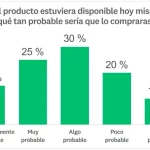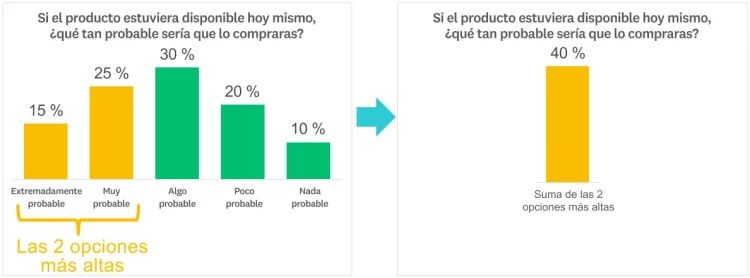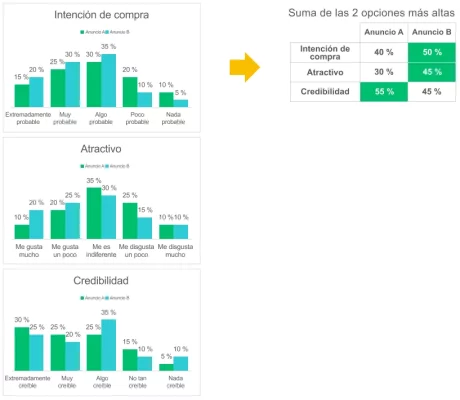Usa la suma de las 2 opciones más altas en el análisis de encuestas

¿Qué probabilidad hay de que tus clientes potenciales compren tus productos? ¿Tus clientes están satisfechos? ¿Tu marca es atractiva?
Es probable que cada una de estas preguntas tenga diversas respuestas, lo cual complica tu capacidad para interpretar las respuestas. Si quieres poner fin al desorden en tus datos, considera la posibilidad de usar la suma de las 2 opciones más altas, una técnica de análisis de encuestas que te permitirá resaltar valores decisivos de una manera sencilla.
Abordaremos cómo esta técnica contribuye al análisis de tu encuesta. Además, analizaremos las diversas formas en que se puede utilizar. Así, la próxima vez que redactes tus preguntas o revises las respuestas, podrás sacar partido de tus conocimientos sobre la suma de las 2 opciones más altas para aprovechar al máximo tu encuesta.
Pero primero, ¿qué es exactamente la suma de las 2 opciones más altas?
Definición
La suma de las 2 opciones más altas (o puntuación de las 2 opciones más altas) es una forma de sintetizar las respuestas positivas de una pregunta de escala Likert. Combina el total de las 2 opciones de respuesta más altas de la escala para crear un solo número. Debido a que es fácil calcularla y que aporta un gran valor al análisis de tu encuesta, esta técnica se emplea de diversas maneras dentro de la investigación de mercado. La lista incluye desde pruebas de anuncios y desarrollo de productos hasta monitoreo de la marca.
Para ayudarte a comprender el proceso de cálculo de la suma de las 2 opciones más altas, veamos un ejemplo.
Cómo calcular la suma de las 2 opciones más altas
Supongamos que eres especialista en marketing de una empresa de alimento para mascotas. Quieres probar un par de ideas publicitarias con tu mercado objetivo: los dueños de mascotas. En tu encuesta, deberías analizar qué tan probable (o poco probable) es que los dueños de mascotas compren tu producto luego de ver un anuncio.
Para obtener una respuesta, puedes usar la pregunta de intención de compra que tiene una escala de 5 puntos:
Si el producto estuviera disponible hoy mismo, ¿qué tan probable sería que lo compraras?
- Altamente probable
- Muy probable
- Algo probable
- Poco probable
- Nada probable
Una vez que hayas recopilado las respuestas, los datos se verían así:

Como especialista en marketing, lo más seguro es que te interese conocer el porcentaje de personas que es probable que compre tu producto luego de ver el anuncio. Así que, en este ejemplo, las respuestas de las 2 opciones más altas son las dos primeras respuestas positivas: Extremadamente probable y Muy probable. Para calcular el porcentaje de las 2 opciones más altas, simplemente suma los porcentajes de estas dos respuestas:
15 % (Extremadamente probable) + 25 % (Muy probable) = 40 % (porcentaje de las 2 opciones más altas)

Consejo profesional: En SurveyMonkey Analyze, puedes calcular el porcentaje de las 2 opciones más altas al combinar las opciones de respuesta.
Ahora que ya sabes cómo calcular la suma de las 2 opciones más altas, hablemos de los motivos para usarla.
¿Por qué usar la suma de las 2 opciones más altas?
1) Simplifica tu análisis. En lugar de revisar más de cinco números, solo tendrás uno.
2) Las comparaciones son rápidas y sencillas. Ya sea que compares resultados de distintas marcas o estímulos (p. ej., al probar conceptos), la suma de las 2 opciones más altas te permite comparar los resultados en paralelo de forma más eficiente.
Volvamos a nuestro ejemplo anterior de la empresa de alimento para mascotas. Imagina que no solo hiciste preguntas sobre la intención de compra, sino también sobre el atractivo del producto y su credibilidad. Con la suma de las 2 opciones más altas, dile adiós a una gran cantidad de gráficas difíciles de interpretar y dale la bienvenida a las tarjetas de puntuación sencillas y claras.

3) Las tendencias se vuelven más fáciles de detectar. Al hacer un seguimiento de los indicadores a lo largo del tiempo, la suma de las 2 opciones más altas te ayuda a identificar las tendencias en tus datos.
Por ejemplo, digamos que estás haciendo un seguimiento del atractivo de tu propia marca en comparación con la de tu principal competidor. Para ello empleas una pregunta con una escala de 5 puntos que mide la percepción relativa de cada marca. A medida que realizas un seguimiento de los resultados cada trimestre, verás las tendencias de cada marca, una al lado de la otra.
La técnica de la suma de las 2 opciones más altas te permite captar tu análisis durante un periodo con una sola imagen.

¿Quieres poner a prueba tu instinto?
SurveyMonkey Audience tiene consumidores en todo el mundo que te dirán lo que opinan.
Variaciones de la suma de las 2 opciones más altas
Existen diversas variaciones de la suma de las 2 opciones más altas. Estas son algunas de las más comunes:
Suma de la opción más alta
Usa la suma de la opción más alta cuando solo te interese conocer cuántas personas eligieron la opción más alta de tu escala. Por ejemplo, si buscas mejorar la retención de clientes y planeas usar una pregunta de valoración con estrellas para medir la satisfacción, podría interesarte más aumentar el porcentaje de clientes que te dan 5 estrellas a lo largo del tiempo.
¿Cómo calificarías nuestros servicios?
- ★★★★★
- ★★★★
- ★★★
- ★★
- ★
Para calcular la suma de la opción más alta, simplemente averigua el porcentaje de encuestados que seleccionaron la primera opción de respuesta. Por lo tanto, si el 20 % de los encuestados selecciona 5 estrellas, tu suma de la opción más alta simplemente sería del 20 %.
Suma de las 3 opciones más altas
Usa la suma de las 3 opciones más altas para las preguntas de escala Likert que superen la escala de 5 puntos. El cálculo es similar al de la suma de las 2 opciones más altas, solo que debes agregar las 3 respuestas positivas más altas.
¿Qué tan satisfecho/a o insatisfecho/a estás con el servicio al cliente que recibiste?
- Altamente satisfecho/a
- Muy satisfecho/a
- Satisfecho/a
- Ni satisfecho ni insatisfecho/a
- Insatisfecho/a
- Muy insatisfecho/a
- Extremadamente insatisfecho/a
Suma de las 2 opciones más bajas
Cuando buscas agregar las respuestas negativas de una pregunta de escala Likert, puedes usar la suma de las 2 opciones más bajas en lugar de usar las 2 opciones más altas. Por ejemplo, considera esta pregunta sobre lealtad a la marca de nuestra plantilla de encuesta sobre conversión de marca:
¿Qué tan probable es que cambies a otra marca para tu próxima compra?
- Altamente probable
- Muy probable
- Algo probable
- Poco probable
- Nada probable
Para crear una métrica que cuantifique a los clientes leales, usa la suma de las 2 opciones más bajas. Esto simplemente implica sumar las 2 respuestas más bajas (“Poco probable” y “Nada probable”).
Suma ponderada de las 2 opciones más altas
De vez en cuando, querrás profundizar en la suma de las 2 opciones más altas. Considera el siguiente desglose para una pregunta de intención de compra sobre dos conceptos de producto diferentes:
Producto A
Suma de las 2 opciones más altas: 40 %
Extremadamente probable: 15 %
Muy probable: 25 %
Producto B
Suma de las 2 opciones más altas: 40 %
Extremadamente probable: 30 %
Muy probable: 10 %
En este caso, las sumas de las 2 opciones más altas de los dos productos son las mismas, por lo que podrías llegar a la misma conclusión. Sin embargo, el producto B tiene el doble de respuestas para “Extremadamente probable”, lo que le otorga una intención de compra significativamente más alta que el producto A.

Este ejemplo muestra que no siempre puedes confiar en la suma agregada de las 2 opciones más altas de forma aislada, en especial cuando las comparaciones son similares en magnitud. El uso de una suma ponderada de las 2 opciones más altas (o la suma de la opción más alta) puede proporcionar más claridad y ayudarte a evitar la necesidad de volver a poner a prueba los anuncios o volver a enviar la encuesta a un tamaño de la muestra más grande.
Cómo calcular la suma ponderada de las 2 opciones más altas
La suma ponderada de las 2 opciones más altas se calcula de la siguiente manera:
(Suma de la opción más alta * ponderación de la opción más alta) + (Suma de la segunda opción más alta * ponderación de la segunda opción más alta) = Suma ponderada de las 2 opciones más altas
El elemento un tanto subjetivo de la ecuación son las ponderaciones en sí. Algunas reglas generales para determinarlas son:
- Las ponderaciones de la opción más alta y la segunda opción más alta no pueden ser iguales.
- Las dos ponderaciones deben sumar 1.
- La ponderación de la opción más alta suele ser mayor que la ponderación de la segunda opción más alta. Esto se debe a que la opción más alta de una pregunta de escala Likert ordinal suele ser la respuesta positiva más extrema, lo cual predice mejor el desempeño del mercado.
- Al determinar las ponderaciones, debes tener en cuenta la categoría del producto y el nivel de toma de decisiones de los consumidores. Cuando los productos son más asequibles y fáciles de comprar (p. ej., la pasta dental), los consumidores dan respuestas más precisas a las encuestas, por lo que puedes dar una ponderación más alta a la opción más alta. Cuando la compra de productos requiera más consideración (p. ej., comprar un auto), concede a la opción más alta una ponderación ligeramente superior.
La técnica de la suma de las 2 opciones más altas es fundamental para los investigadores de mercado. Ya sea que hayas recopilado resultados relacionados con pruebas de anuncios, comentarios sobre productos o sobre el conocimiento de una marca, la suma de las 2 opciones más altas mejorará la eficacia del análisis de tu encuesta y te ayudará a tomar las decisiones correctas.
Descubre más recursos

Directorio de herramientas
Conoce nuestros kits de herramientas, diseñados para que aproveches la retroalimentación en tu puesto o industria.

¿Qué es un cuestionario? Definición, ejemplos y usos
Aprende a usar cuestionarios para recopilar datos y usarlos en investigaciones de mercado. Presentamos ejemplos, plantillas y casos de uso.

Crea formularios sobre desvinculación laboral y averigua qué puedes mejorar
Haz las preguntas correctas en tu encuesta sobre desvinculación laboral y reduce la deserción con nuestro generador de formularios y las plantillas.

Recibe los permisos necesarios con los formularios de consentimiento en línea
Obtén los permisos necesarios con nuestras plantillas de formulario de consentimiento. Suscríbete gratis y personaliza tu formulario.